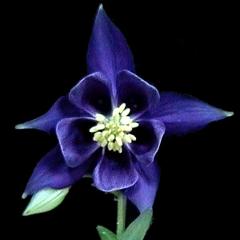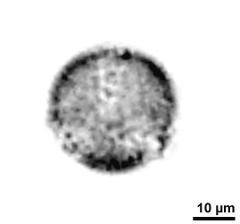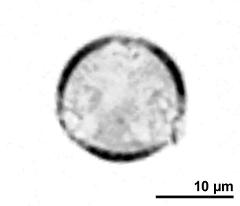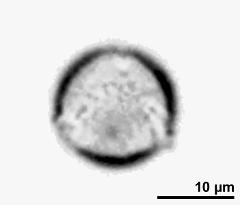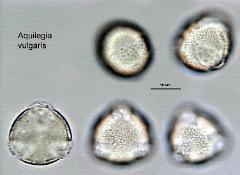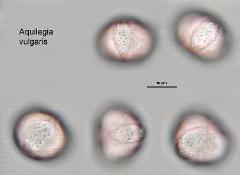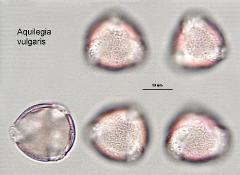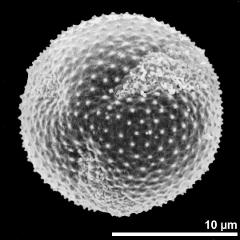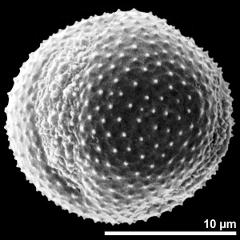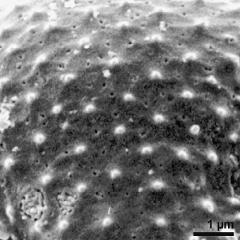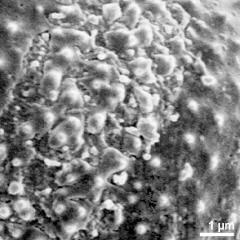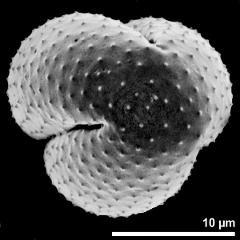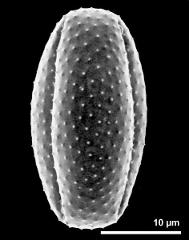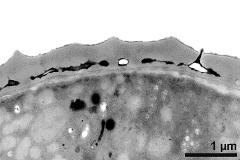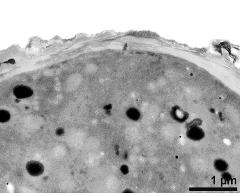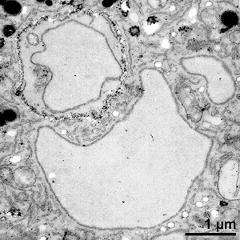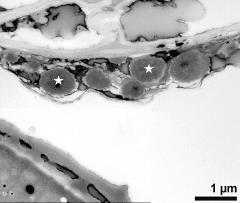Aquilegia vulgaris
Taxonomy: Angiospermae, Ranunculales, Ranunculaceae, Aquilegia
Links: http://flora.nhm-wien.ac.at/Seiten-Arten/aquilegia-vulgaris.htm
Published: 2020-11-11
Pollen Description
Shape, Size and Aperture
pollen unit: monad, dispersal unit and peculiarities: monad, size (pollen unit): small (10-25 µm), size of hydrated pollen (LM): 21-25 µm, shortest polar axis in equatorial view (LM): 16-20 µm, longest polar axis in equatorial view (LM): 16-20 µm, shortest diameter in equatorial or polar view (LM): 16-20 µm, longest diameter in equatorial or polar view (LM): 16-20 µm, pollen class: colpate, polarity: isopolar, P/E-ratio: -, shape: spheroidal, outline in polar view: circular, dominant orientation (LM): oblique, P/E-ratio (dry pollen): prolate, shape (dry pollen): -, outline in polar view (dry pollen): lobate, infoldings (dry pollen): aperture(s) sunken, aperture number: 3, aperture type: colpus, aperture condition: tricolpate, colpate, aperture peculiarities: aperture membrane ornamented
Ornamentation and Structure
LM ornamentation LM: gemmate, scabrate, verrucate, nexine: -, sexine: -, SEM ornamentation SEM: perforate, microechinate, suprasculpture SEM: -, TEM tectum: eutectate, infratectum: columellate, foot layer: discontinuous, endexine: compact-continuous, intine: monolayered, wall peculiarities: -, supratectal element: -
Miscellaneous
pollen coatings: pollenkitt, reserves in cytoplasm: lipids, starch, cell number: 2-celled, Ubisch bodies: present
Author(s) of diagnosis: Oberschneider, Wolfgang; Heigl, Helmut
Pictures
Picture legend
- flower(s), photographer: Oberschneider, W.
- upper focus - fresh, acetolyzed, unstained, photographer: Oberschneider, W.
- optical section - fresh, acetolyzed, unstained, photographer: Oberschneider, W.
- lower focus - fresh, acetolyzed, unstained, photographer: Oberschneider, W.
- hydrated Pollen - fresh, glycerine, unstained, photographer: Heigl, H.
- hydrated Pollen - fresh, glycerine, ruthenium red, photographer: Heigl, H.
- hydrated Pollen - fresh, glycerine, ruthenium red, photographer: Heigl, H.
- polar view - fresh, rehydration (water) & chloroform & critical point dried & sputter coated with gold, photographer: Oberschneider, W.
- equatorial view - fresh, rehydration (water) & chloroform & critical point dried & sputter coated with gold, photographer: Oberschneider, W.
- exine surface - fresh, rehydration (water) & chloroform & critical point dried & sputter coated with gold, photographer: Oberschneider, W.
- detail of aperture - fresh, rehydration (water) & chloroform & critical point dried & sputter coated with gold, photographer: Oberschneider, W.
- polar view of dry pollen grain - dry, sputter coated with gold, photographer: Oberschneider, W.
- dry pollen grain in equatorial view - dry, sputter coated with gold, photographer: Oberschneider, W.
- pollen wall - fresh, glutaraldehyde & osmium & potassium ferrocyanide, uranyl acetate & lead citrate, photographer: Oberschneider, W.
- aperture - fresh, glutaraldehyde & osmium & potassium ferrocyanide, uranyl acetate & lead citrate, photographer: Oberschneider, W.
- vegetative nucleus and generative cell (top) - fresh, glutaraldehyde & osmium & potassium ferrocyanide, modified Thiéry-test, photographer: Oberschneider, W.
- pollen wall (left) and tapetum cells with Ubisch bodies (asterisks) - fresh, glutaraldehyde & osmium & potassium ferrocyanide, uranyl acetate & lead citrate, photographer: Oberschneider, W.
Literature
- (1991) The Northwest European Pollen Flora, 51. Ranunculaceae. Rev Palaeobot Palynol 69: 117-271
- (1986) Contribución al conocimiento palinológico de la familia Ranunculaceae en Andalucía. II. Subfam. Ranunculoideae. Candollea 41: 75-85
- (1990) Phylogenetic considerations on the subfamily Thalictroideae (Ranunculaceae). Cathaya 2: 181-190
- (1991) Palynotaxonomy and phylogeny of Ranunculaceae. Geophytology 21: 207-210
- (1937) Pollen morphology in Ranunculaceae, Lardizabalaceae and Berberidaceae. J Jap Bot 8: 19-46
- (1998) Pollenmorphologie der Ranunculanae. Diplomarbeit. Universität Wien : 125 pp
- (1980) Palynomorphological characteristics of the Bulgarian representatives of the family Ranunculaceae Juss. IV. Phytology (Bulg Acad Sci) 14: 3-50
- (1992) Pollen grain morphology in the genus Aquilegia (Ranunculaceae) of the USSR flora in connection with its systematics. Bot Journ USSR 77: 32-39
- (1963) Studies of Indian pollen grains - II. Ranunculaceae. Pollen et Spores 5: 285-296
- (1936) Pollen grains in the identification and classification of plants - VII. Ranunculaceae. Bull Torrey Bot Club 63: 495-514
- (1994) Exkursionsflora von Österreich : 1180
- (1998) Preparing living pollen material for scanning electron microscopy using 2,2-dimethoxypropane (DMP) and criticalpoint drying. Biotechnic Histochem 73: 137–143
Copyright and Citation
Cite this publication as:
Oberschneider W., Heigl H. 2020. Aquilegia vulgaris. In: PalDat - A palynological database. https://pc8.botanik.univie.ac.at/pub/Aquilegia_vulgaris/303896;jsessionid=DF9AD0F262095F87CB528A3D7857C2A4; accessed 2025-07-02

